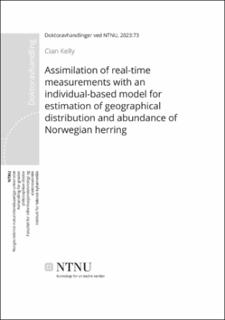| dc.contributor.advisor | Alver, Morten Omholt | |
| dc.contributor.advisor | Michelsen, Finn Are | |
| dc.contributor.advisor | Kolding, Jeppe | |
| dc.contributor.author | Kelly, Cian | |
| dc.date.accessioned | 2023-05-05T09:18:38Z | |
| dc.date.available | 2023-05-05T09:18:38Z | |
| dc.date.issued | 2023 | |
| dc.identifier.isbn | 978-82-326-6907-3 | |
| dc.identifier.issn | 2703-8084 | |
| dc.identifier.uri | https://hdl.handle.net/11250/3066402 | |
| dc.description.abstract | The fishing industry faces both challenges and opportunities in the wake of the green transition in fisheries. Challenges stem from attempts to reduce the carbon footprint of activity while simultaneously providing food security. Opportunities arise where reducing fuel consumption can both drive down operating costs and increase the value of landings, a positive sum result for stakeholders. Technological innovation have reduced costs in the past and likely will in the future. However, innovations have also led to negative effects on fish stocks, and fisheries management is key to mitigating undesirable outcomes. To facilitate both economic and environmentally sustainable harvesting, real-time information about the state of the fish stock is advantageous. Sophisticated modelling approaches can be used to predict ocean resources at high spatial and temporal resolutions, and provide insight into the state of ecosystems. This thesis proposes a model-based estimation approach to predicting real-time geographical distribution and abundance of fish stocks. Providing recurrent predictions of fish distributions has the potential to reduce the time vessels spend searching for suitable fishing grounds and decrease fuel consumption in the fishing industry.
The model-based estimation approach is inspired by work done by Jens Glad Balchen, the founder of the Department of Engineering Cybernetics (ITK) at NTNU. He was an advocate of the power of modelling and estimation theory to predict ocean resources for harvesting. In that vein, we combine a model commonly used in fisheries research, called an Individual-Based Model (IBM), with an estimation procedure familiar in cybernetics, called an Ensemble Kalman Filter (EnKF). We chose the commercially important Norwegian Spring Spawning Herring (NSSH) as the model stock based on discussions with fishers participating in the project. The IBM forecasts the spawning migration of NSSH, with behaviour of individuals driven mainly by the Norwegian coastal current. The model structure was calibrated using survey data and compared with catch data from the Norwegian fishing fleet. After finding a suitable agreement between model output and observations, random disturbances were added to the IBM, accounting for unmodelled phenomena and other uncertainties in the model structure. This includes annual variations in migration patterns, reflected in variations in fishing grounds and search routes for fishing vessels. Incorporating random disturbances produced an ensemble of instances of the NSSH migration, with the variability within the ensemble representing the uncertainty in the model predictions. For compatibility with the EnKF, each realization of the IBM was mapped to a density field forming a state space for the EnKF correction step, and corrections were applied to the field based on incoming measurements. The IBM was then adjusted to account for the applied corrections. The model predictions were improved using the assimilation procedure, which was demonstrated using a twin model simulation experiment. In addition, we proposed a machine learning method for generating synthetic observations using vessel positional systems as input and normalized fish densities as target output. This increased the number of measurements available to correct the IBM.
Data Assimilation reduces model uncertainty and provides information on unobserved areas with high catch potential during the fishing season. The model-based estimation approach is therefore being integrated into a web-based Decision Support System (DSS) developed during this project. We discuss how fishers have contributed to the development of the system through questionnaires and project meetings. The DSS can both integrate the real-time estimates from modelling work and facilitate systematic data capture by fishing vessels. Furthermore, data from fishing vessels can improve model structure and predictions by providing input to the assimilation procedure. Future work may include more state variables in the IBM, consider alternative representations of the underlying model and estimation procedure or find new sources of measurements. In addition, one may extend the migration model to include the winter migration from open sea to winter stay areas. | en_US |
| dc.language.iso | eng | en_US |
| dc.publisher | NTNU | en_US |
| dc.relation.ispartofseries | Doctoral theses at NTNU;2023:73 | |
| dc.relation.haspart | Paper 1: Kelly, Cian; Michelsen, Finn Are; Kolding, Jeppe; Alver, Morten. Tuning and Development of an Individual-Based Model of the Herring Spawning Migration. Frontiers in Marine Science 2022 ;Volum 8. s. 1-14. This is an open-access article distributed under the terms of the Creative Commons Attribution License (CC BY). | en_US |
| dc.relation.haspart | Paper 2: Kelly, Cian; Michelsen, Finn Are; Alver, Morten Omholt. An ensemble modelling approach for spatiotemporally explicit estimation of fish distributions using data assimilation. Fisheries Research 2023 ;Volum 261. This is an open access article under the CC BY license (http://creativecommons.org/licenses/by/4.0/). | en_US |
| dc.relation.haspart | Paper 3: Kelly, Cian; Michelsen, Finn Are; Alver, Morten Omholt. Model-based estimation of fish catch potential using assimilation of synthetic measurements from a neural network driven by fishing vessel activity data. This paper is not yet published and is therefore not included. | en_US |
| dc.relation.haspart | Paper 4: Kelly, Cian; Michelsen, Finn Are; Reite, Karl Johan; Kolding, Jeppe; Varpe, Øystein; Prytz Berset, Are; Alver, Morten. Capturing big fisheries data: Integrating fishers’ knowledge in a web-based decision support tool. Frontiers in Marine Science 2022 ;Volum 9. s. 1-11. This is an open access article distributed under the terms of the Creative Commons Attribution License (CC BY). | en_US |
| dc.title | Assimilation of real-time measurements with an individual-based model for estimation of geographical distribution and abundance of Norwegian herring | en_US |
| dc.type | Doctoral thesis | en_US |
| dc.subject.nsi | VDP::Teknologi: 500::Informasjons- og kommunikasjonsteknologi: 550::Teknisk kybernetikk: 553 | en_US |
| dc.description.localcode | Fulltext not available | en_US |

